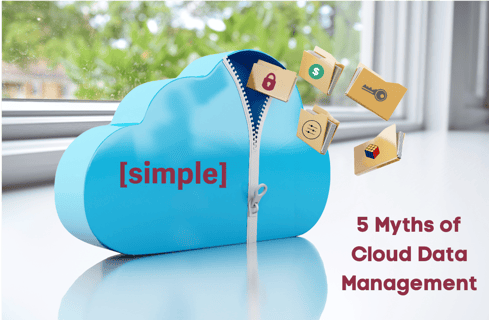5 Myths about Cloud Data Management... and Why They're Wrong

Government organizations recognize they must modernize their IT environments by migrating to the cloud. Doing so helps them attain greater efficiencies, speed of services, flexibility and other benefits. However, a number of persistent myths are holding government decision-makers back from fully embracing cloud solutions.
Simple Technology Solutions (STS) partners with federal agencies to help them migrate efficiently to cloud environments. We have established cloud security and usage best practices and have operationalized these guidelines using code for maximum transparency and speed. Based on our experience, these are the five myths specifically relating to cloud data management that can hold up IT transformation.
1. The Cloud is Not Secure.
It’s natural for organizations to have some security concerns when moving their data management to the cloud. These concerns might involve cyber-attacks, unauthorized access or data breaches.
It is true that the skillset consistent with a traditional, on premises security road map is not necessarily right for cloud and cloud security deployments. But with the correct approach the cloud can actually be more secure than on-premises data management. Consulting firm KPMG makes the following recommendations:
- Automate your cloud security, especially around deployment, monitoring and recovery, eliminating manual processes
- Build a centralized cloud security team that comes from the development ranks versus leading with traditional security skills
- Lock in the operational responsibilities in a shared model, defining which entity is responsible for security in the cloud and which entity has responsibility for security of the cloud
- Look to security posture management tools that have pre-configured policy checks mapped to different regulatory regimes
- Construct an incident response process that is in sync with your broad cloud strategy
Technologies for cloud data management have advanced so quickly that Gartner estimates that 95 percent of cloud security failures are due to mistakes by the customer, not the cloud infrastructure.
2. Cloud Data Management Software is Expensive.
It is not true that all cloud data management software is expensive. There are many cloud data management solutions available on the market, and the cost of these solutions can vary widely. Some cloud data management solutions are offered for free, while others can be quite expensive.
It is important to consider the specific needs of your organization when choosing a cloud data management solution. If you have a large amount of data that needs to be stored and managed, you may need to invest in a more expensive solution that can handle the scale and complexity of your data. On the other hand, if you have a small amount of data or relatively simple data management needs, you may be able to find a more affordable solution that meets your needs.
It is also worth noting that many cloud data management solutions offer flexible pricing models, such as pay-as-you-go pricing or tiered pricing based on usage. This can help to make the cost of these solutions more predictable and manageable for organizations of all sizes.
To find the best solution for your organization, these best practices are a good start:- Define your goals - The first step in any cloud data management project is to define what the organization hopes to accomplish. Without clear goals, it's impossible to implement a cost-effective cloud data management strategy that's well suited to the organization's needs.
- Which data sets need to move to the cloud? - Although a case can be made for migrating all data to the cloud, there might be benefits to leaving certain data sets in on-premises data centers. For example, an application that is sensitive to latency will likely need the data to remain near the application, which might rule out the use of cloud services.
- Automate data protection (again!) - Many cloud providers automatically back up data, but if the CSP’s practices don't comply with your organization's SLAs, then you must implement your own automated data protection strategy.
3. The Cloud Makes Data Access Harder.
This myth has much more to do with human nature than technological reality. As much as our “gut” may tell us that data is harder to access once it no longer sits on-premises, the cloud actually allows users to access their data from any device with an internet connection.
The data is now stored “somewhere” in the cloud, but employees can access it from anywhere in the world, while another organization maintains the infrastructure. That’s the fundamental beauty of cloud computing, and it is also an integral reason why companies can conduct their operations much more smoothly all over the world.
For enterprise customers, cloud resources provided could include servers, CPU cores, data storage, network infrastructure and virtualization. In addition, cloud-based data management solutions often include features such as file sharing and collaboration tools, which can make it easier for teams to work together and access the data they need.
Finally, not only does the cloud make data access easier, but it also allows for stronger compliance with internal security rules. This can be accomplished by how the infrastructure is constructed, often referred to as “governance by code.” This is something STS has helped many agencies implement.
4. The Cloud Means Losing Control of Your Data.
This is another myth that feels intuitively correct to many of us, but the opposite is usually true.
Many cloud data management solutions offer a range of security and control features that can help you maintain control over your data. These may include access controls, data encryption, and auditing and compliance tools.
In addition, it is important to carefully review the terms of service and privacy policies of any cloud data management solution you are considering. You need to understand how your data will be used and protected. This can help you make informed decisions about the level of control you have over your data in the cloud.
Central to feeling comfortable with the full picture is understanding the shared responsibility model. The cloud shared responsibility model is a framework that defines the roles and responsibilities of a cloud provider and a customer in the management and protection of data and resources in the cloud.
Under the cloud shared responsibility model, the cloud provider is responsible for the security and maintenance of the infrastructure that supports the cloud, including the hardware, networking, and physical security of the data centers.
The cloud customer is responsible for the security and protection of their own data and applications that run in the cloud. This includes things like configuring and managing access controls, implementing security measures such as data encryption, and ensuring compliance with relevant laws and regulations.
The cloud shared responsibility model helps to clearly define the roles and responsibilities of both the cloud provider and the customer and ensures that both parties are working together to ensure the security and protection of data and resources in the cloud.
5. Hybrid Environments Make Data Management Too Complex.
For enterprises it has become increasingly common to utilize hybrid cloud environments. A hybrid cloud environment is a type of computing environment that combines on-premises infrastructure, such as servers and storage systems, with a public cloud platform.
In a hybrid cloud environment, an organization can use the public cloud platform to host certain workloads or applications, while still maintaining control over certain data and resources by keeping them on-premises.
The hybrid cloud model allows organizations to take advantage of the scalability, flexibility, and cost-effectiveness of the public cloud, while still retaining control and visibility over their data and resources.
This can be particularly useful for public sector organizations that have regulatory or compliance requirements that require them to keep certain data on-premises, or for organizations that want to maintain control over certain critical assets.
Overall, a hybrid cloud environment is no more complex than on-premises or cloud environments. Hybrid deployments provide organizations with the benefits of both on-premises and public cloud environments and can be a useful way to optimize their IT infrastructure and resources.
We hope the reasons above fully refute these myths that can hold back cloud adoption. There are multiple reasons government agencies to leave myths behind and embrace the cloud, including cost savings, scalability, improved security, better collaboration and enhanced access to data.
Are any of these myths regarding cloud data management keeping you from taking advantage of the cloud for your IT requirements? Let’s talk and see if we can put our experience to work for you. Contact us to start a conversation around your needs.



